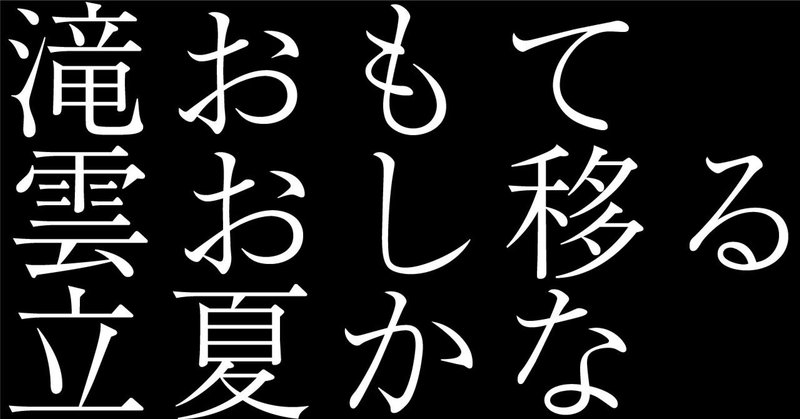
#312 AIが俳句を解釈したらこうなった。 「滝おもて雲おし移る立夏かな」飯田蛇笏
滝おもて雲おし移る立夏かな
飯田蛇笏
"On the waterfall’s surface, clouds glide across as Rikka begins."
Iida Dakotsu

解説:
この俳句「滝おもて雲おし移る立夏かな」は、飯田蛇笏によって作られました。立夏は、暦上で春から夏へと移り変わる時期を指し、夏の訪れを告げる重要な節目の一つです。この俳句は、滝と空の雲の移ろいを通じて、立夏の時期に特有の情景を描いています。
風物詩
「立夏」は暦の上で夏の始まりを意味し、新緑が深まり、日差しが強くなり始める時期です。滝の水しぶきやその勢いは、立夏を迎える頃の自然の活力を象徴し、自然のエネルギーを感じさせます。雲が滝の表面に映りこむ様子は、この新たな季節の到来を示し、清涼感とともに自然の豊かな美しさを感じさせます。
表現手法
「滝おもて」という表現は、滝の表面、つまり水の流れの部分を指しており、「雲おし移る」は、その水面に空の雲が映っている様子を表現しています。滝の表面が、流れる水の中で映る雲を映し出す様子を「おし移る」と表現することで、動的な自然の姿を巧みに捉えています。「かな」という詠嘆の助詞で結ぶことで、その情景に対する驚きや感嘆の気持ちが強調されています。
情緒や感情
この俳句は、立夏の時期に見られる滝と空の情景に対する感嘆を示しています。滝の水面に雲が映るという動的でありながら儚い瞬間を捉え、その背後にある自然の活力やエネルギー、季節の変化を感じさせます。この一句は、自然の一瞬を捉えることで、立夏の到来に対する期待感や、新しい季節への感慨を呼び起こします。
全体として、この俳句は、立夏という重要な節目における自然の動きと、その中にある美しさを見事に表現しています。読者に対して、季節の移り変わりと自然のダイナミックな変化を感じさせる作品です。
英訳:
Explanation
This haiku by Iida Dakotsu beautifully captures the transition to summer through the imagery of a waterfall reflecting the shifting clouds as Rikka (the beginning of summer in the traditional Japanese calendar) arrives.
Seasonal Imagery
Rikka, one of the 24 seasonal divisions of the traditional Japanese calendar, marks the point where spring transitions into early summer. The landscape is characterized by lush greenery and growing vitality, while temperatures begin to rise. In this haiku, the reflection of clouds moving across the waterfall’s surface symbolizes the changing season, highlighting nature’s dynamic energy.
Artistic Expression
The phrase "On the waterfall’s surface" creates a vivid image of a flowing water surface. "Clouds glide across" reflects the subtle motion of clouds mirrored on the water, giving the reader a sense of both movement and tranquility. The use of "Rikka begins" is a poignant reminder that summer has arrived, emphasizing the poetic beauty of the seasonal transition.
Emotional and Sentimental Tone
This haiku evokes a sense of wonder and anticipation as the seasons shift. The reflection of clouds in the waterfall offers an ephemeral beauty, emphasizing the transient nature of time. The haiku expresses a serene joy in observing the interplay between water and sky, providing a sense of calm while inspiring reflection on the cyclical changes in nature.
Overall, this haiku elegantly combines the natural phenomenon of a waterfall with the larger cosmic cycle of the seasons. It invites readers to reflect on nature’s delicate interplay between movement and stillness while celebrating the beauty of the passing seasons. It offers a gentle reminder of nature’s dynamic energy and the continuity that Rikka brings as summer approaches.
飯田蛇笏

飯田蛇笏(1885年 - 1962年)は、山梨県出身の俳人で、本名は飯田武治。彼は高浜虚子に師事し、大正時代の俳句界で活躍しました。蛇笏は自然や伝統的な日本文化に根ざした句を詠み、格調の高い作品で知られています。彼の句集「雲母」には、写生句や古典的な表現が多く取り入れられ、その代表的な句に「春めきて ものの果てなる 空の色」や「打水の ころがる玉を 見て通る」などがあります。
蛇笏は早稲田大学英文科に入学し、若山牧水らと交友を深めました。その後、虚子が主宰する「ホトトギス」や松根東洋城の「国民俳壇」に投句するなど、さまざまな活動を行いました。彼の詳細な生涯や俳句作品については、Wikipediaの飯田蛇笏のページで確認できます。
五月七日
(英訳:ChatGPT 解説:Bing / ChatGPT 画像生成:midjourney)
この記事が気に入ったらサポートをしてみませんか?
